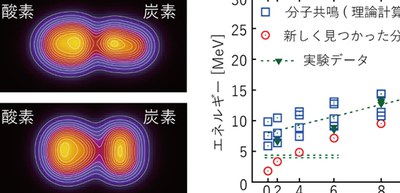
Molecular resonances, candidates for creating elements in universe, theoretically validated
Will lead to elucidation of the origin of elements
A group of researchers from National Institute of Technology, Kagawa College (Kagawa Kosen), Hokkaido University, and Osaka University has clarified mechanisms behind molecular resonance energy, which is thought to promote the formation of elements in the universe. This group’s achievements will lead to the elucidation of the origin of elements.
It was predicted that carbon (C)-oxygen (O) fusion reactions during a supernova explosion played an important role in the formation of elements. However, since it is difficult to experimentally obtain the fusion reaction rate, the theoretical validation of this rate was much anticipated.
This group tried to clarify the properties of cluster structures in the highly excited states of nuclei, especially to quantitatively obtain molecular resonance energy near the threshold of nuclear fusion, which is important for the synthesis of elements.
This group performed computer simulations taking rotation effects of carbon nuclei into consideration. Since the nuclei of carbon are oblate like a squashed sphere, they can face various directions when inducing molecular resonances. The researchers superposed wave functions of the carbon nuclei with various orientations in order to describe cluster rotation precisely, clarifying the mechanism of resonances at deep sub-barrier energy, which is significantly less than the Coulomb barrier, the energy barrier that two nuclei need to overcome to undergo a nuclear reaction.
Using antisymmetrized molecular dynamics (AMD), which describes the motion of a proton and a neutron around a nucleus by wave packets, they examined the nature of molecular resonances, suggesting the possibility that C-O resonances also occur at the deep sub-energy barrier.
They also pointed out the possibility that molecular resonances of weakly-bound C-O isotopes at deep sub-barrier energy may cause C-O nuclear fusion reactions in supernova nucleosynthesis (the nucleosynthesis of chemical elements during a supernova explosion) and create a large number of magnesium (Mg) and silicon (Si) nuclei.
In this study, numerical simulations clarified that molecular resonances were present in both high and low energy regions. Molecular resonances in high energy regions corresponded to experimental molecular resonance states, showing the reliability of this study.
Studying carbon resonances is important in understanding the origin of elements heavier than carbon. This group plans to examine C-C fusion reactions using similar computer simulations in order to comprehensively understand the properties of molecular resonances. This will clarify which elements and how much of them are created in supernova explosions, elucidating the origin of elements in the universe.

Figure 1
The article, “12 C+ 16 O molecular resonances at deep sub-barrier energy,” was published in Physics Letters at DOI: https://doi.org/10.1016/j.physletb.2019.135086.
